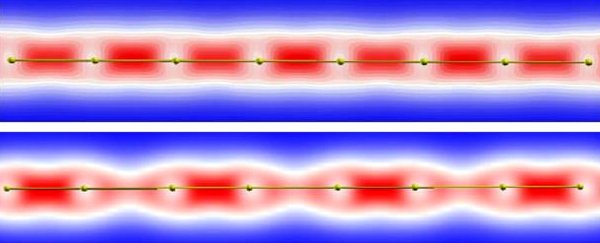We all love graphene - the one-atom-thick sheets of carbon aren't just super flexible, harder than diamond, and stronger than steel, they've also recently become superconductors in their own right.
But it's not the only over-achieving nanomaterial out there. Researchers have just simulated a stretched out, one-dimensional (1D) chain of boron, predicting that the material could have even weirder properties than graphene.
To be clear, 1D boron chains haven't been created as yet - so far, this research is purely based on detailed computer simulations of the new material.
But labs have already successfully synthesised atom-thick and fullerene - cage-like buckyball - forms of boron, and single-atom-thick-carbon chains known as carbyne (pictured above) have also been created. So the researchers predict it's only a matter of time before 1D boron-atom chains become a reality too.
If that's the case, we're in for a treat, because the simulations show that when 1D forms of boron are made, they have some pretty incredible properties.
For example, when they're stretched out, these metallic chains become antiferromangetic semiconductors - meaning a non-magnetic metal that can conduct electricity with zero resistance. And when they're released, they fold up back into neat two-atom-thick ribbons.
The material also is predicted to have mechanical stiffness on par with the highest-performing nanomaterials known to science.
And they can act as tiny constant-force springs - a rule-breaking type of spring that exerts constant force over its range of motion (most other springs exert more force the more they're stretched).
While this work is still theoretical, it's not that far outside the realms of possibility. The simulations were created by a team at Rice University, which specialises in atom-level computer simulations of materials that don't exist yet.
And their track record is pretty good. The team has previously predicted and simulated the behaviour of two-dimensional films of boron called borophene, that are similar to graphene, as well as carbon-atom chains, and boron fullerenes.
And all of those materials have since been created by labs.
"Our work on carbyne and with planar boron got us thinking that a 1D chain of boron atoms is also a possible and intriguing structure," said lead researcher Boris Yakobson.
"We wanted to know if it is stable and what the properties would be. That's where modern theoretical-computational methods are impressive, because one can do pretty realistic assessments of non-existing structures."
Unlike graphene, which is two-dimensional because it's an entire sheet of one-atom-thick carbon, the boron structure that the Rice University team is simulating exists on just one dimension, because it's made of either a chain of single atoms, or a ribbon of two-atoms.
Rather than being two separate structures, the ribbon and the chain are actually two well-defined phases of 1D boron.
That means that as 1D boron is stretched out, it transitions from a two-atom ribbon into a single-atom chain, and then transitions back again as the pressure is released.
You can see that happening in the simulation below of a 64-atom boron chain, which is stretched to breaking point:
"Boron is very different from carbon," said Yakobson. "It prefers to form a double row of atoms, like a truss used in bridge construction. This appears to be the most stable, lowest-energy state.
"If you pull on it, it starts unfolding; the atoms yield to this monatomic thread. And if you release the force, it folds back," he added. "That's quite fun, structurally, and at the same time it changes the electronic properties."
What's cool is that each of the two phases have their own unique abilities - the single-atom chain is a semiconductor, and the two-atom ribbon is an incredibly stiff metal that's resistant to deformation.
"That makes it an interesting combination: when you stretch it halfway, you may have a portion of ribbon and a portion of chain. Because one of them is metal and the other is a semiconductor, this becomes a one-dimensional, adjustable 'Schottky junction'," said Yakobson.
A Schottky junction is a barrier to electrons at the junction of a metal and a semiconductor, and is commonly used as a diode to control the current and only allow it to flow in one direction.
The spin of the atoms in the material is intriguing, too - when stretched into the one-atom chain, the direction of the atoms' 'up' or 'down' spin states align in opposite directions, making it antiferromagnetic.
Researchers are currently very interested in antiferromagnetic materials - particularly those that are also great at conducting electricity - for the development of spintronics, which are futuristic, high-performance electronic devices.
We have no idea as yet if these 1D boron chains could ever exist - but the fact that the material is predicted to have such awesome properties means it's likely scientists are going to do their best to make them in the lab.
And you never know what other unique finds they might stumble across in the process.
"Even if they never exist, they're still important, since we're probing the limits of possibility, sort of the final frontier," said Yakobson.
The research has been published in the Journal of the American Chemical Society.
